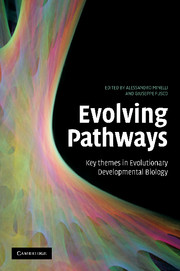Book contents
- Frontmatter
- Contents
- Contributors
- Preface
- Introduction: Pathways of change
- Part I Thinking about evolution by taking development on board
- Part II Evo-devo: methods and materials
- Part III Evolving diversity
- Part IV Evolving body features
- 17 Urbisexuality: the evolution of bilaterian germ cell specification and reproductive systems
- 18 Thoughts and speculations on the ancestral arthropod segmentation pathway
- 19 Evolution of neurogenesis in arthropods
- 20 Arthropod appendages: a prime example for the evolution of morphological diversity and innovation
- 21 Ontogeny of the spiralian brain
- Index
- References
18 - Thoughts and speculations on the ancestral arthropod segmentation pathway
Published online by Cambridge University Press: 08 August 2009
- Frontmatter
- Contents
- Contributors
- Preface
- Introduction: Pathways of change
- Part I Thinking about evolution by taking development on board
- Part II Evo-devo: methods and materials
- Part III Evolving diversity
- Part IV Evolving body features
- 17 Urbisexuality: the evolution of bilaterian germ cell specification and reproductive systems
- 18 Thoughts and speculations on the ancestral arthropod segmentation pathway
- 19 Evolution of neurogenesis in arthropods
- 20 Arthropod appendages: a prime example for the evolution of morphological diversity and innovation
- 21 Ontogeny of the spiralian brain
- Index
- References
Summary
In the past decade or so, there has been a significant increase in the available data on the developmental mechanisms underlying the process of segmentation in a wide range of arthropod taxa. This large body of data makes it possible to attempt, albeit cautiously, a comparative analysis of the various aspects of the segmentation process, and to try to find which of its features and components may have been present in the arthropod common ancestor. A recent review (Peel et al. 2005) covers much of what is known about the diversity of segmentation processes in arthropods, although even at the time of this writing, less than a year later, there is already a substantial amount of newly published data not covered therein. My aim in this chapter is not to repeat the review and synthesis presented in Peel et al. (2005), but to build on it, adding the most recent data, and expand the discussion into the more speculative domain of evolutionary reconstructions. The reader is encouraged to refer to that review for more details of the currently available data and for a more complete bibliography.
When addressing a large-scale evolutionary question, such as that suggested in the title of this chapter, it is important to define the boundaries of the problem discussed. In this review, I will focus only on the mechanisms of trunk segmentation, ignoring the differentiation and segmentation of the head region, and the posterior unsegmented region.
- Type
- Chapter
- Information
- Evolving PathwaysKey Themes in Evolutionary Developmental Biology, pp. 343 - 358Publisher: Cambridge University PressPrint publication year: 2008
References
- 9
- Cited by



